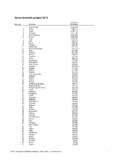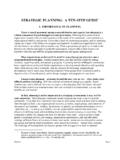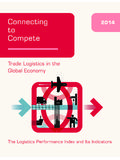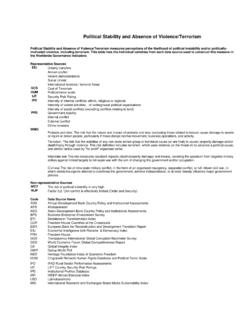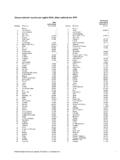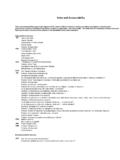Transcription of Legal Corruption - World Bank
1 1 Legal Corruption Daniel Kaufmann1 and Pedro C. Vicente2 Second Draft, October, 2005 Abstract: We challenge the conventional definition of Corruption as the abuse of public office for private gain , making a distinction between Legal and illegal forms of Corruption , and paying more attention to corporate patterns of Corruption (which also affect public Corruption ). We undertake to identify general determinants of the pattern of Legal and illegal Corruption worldwide, and present a model where both Corruption (modelled explicitly in the context of allocations) and the political equilibrium are endogenous. Three types of equilibrium outcomes are identified as a function of basic parameters, namely initial conditions (assets/productivity), equality, and fundamental political accountability.
2 These equilibria are: i) an illegal Corruption equilibrium, where the political elite does not face binding incentives; ii) a Legal Corruption equilibrium, where the political elite is obliged to incur on a cost to deceive the population, and, iii) a no- Corruption equilibrium, where the population cannot be deceived. An integral empirical test of the model is performed, using a broad range of variables and sources. Its core variables, namely regarding Legal Corruption (and other manifestations of corporate Corruption ) come from an original survey developed with the World Economic Forum (in the Executive Opinion Survey 2004 of the Global Competitiveness Report). The empirical results generally validate the model and explanations. Some salient implications emerge. JEL Codes: O57, P16.
3 Keywords: Corruption , Lobbying, Influence, Political Economy. Access to the various indices of Legal and illegal corporate Corruption is available at: 1 World bank Institute, World bank . 2 Department of Economics/CSAE, University of Oxford. 2 Are all dinner menus here the same? - asked a key aide to Menem, the Argentinian president during the nineties, to the chef at the presidential residence. The menus change, the presidents change. What never changes is the dinner guests - retorted the chef, referring to the cadre of businessmen who frequented the .. You dance with them what brung ya.
4 - old saying. 1. Introduction Corruption has been brought throughout the last decade to an important position in the development and political economy debate/literature. It has been seen as a primary impediment to growth ( Mauro, 1995, Kaufmann and Kraay, 2002), with dramatic consequences in the developing World . This analysis has been mainly founded on bureaucratic/public sector Corruption , emphasizing in particular manifestations such as administrative bribery. This highlighting reflected the availability of cross-country indices of Corruption that focus on bribery or other illegal forms of Corruption , and it echoed the conceptual underpinnings of the field (which has been viewing Corruption as abuse necessitating an illegal act of public office a public sector-centered definition for private gain )4.
5 However, it is increasingly widely accepted that Corruption may arise through other less obvious forms, which may involve collusion between parties typically both from the public and private sectors, and may be Legal in many countries. Legal lobbying contributions by the private sector in exchange of passage of particular legislation biased in favor of those agents - or allocation of procurement contracts may be regarded as examples of interaction of both private and public sector representatives where the second makes use of her publicly invested power at the expense of broader public welfare. In this context, some empirical attention has already been granted to less classical forms of appropriation of public office/policy for private purposes, not necessarily illegal, such as state capture (viewed as direct sale of public policy) and influence (as the institution of influencing public policy in exchange for votes5).
6 Hellman, Jones, and Kaufmann (2003) assess these 3 Cited by Gabriela Cerrutti and Sergio Ciancaglini in El Octavo C rculo , Editorial Planeta, Serie Espejo de la Argentina, 2nd Edition, 1992, page 103, and extracted from Luis Moreno Ocampo, En defensa Propia, C mo salir de la corrupci n , Editorial Sudamericana, 1993, page 46. 4 See Becker and Stigler (1974) and Rose-Ackerman (1978) for a first approach to the economics of Corruption . Bardhan (1997) presents a review of the economics literature on Corruption , where this definition is taken as the most commonly used. 5 This is the notion implicitly taken in Shleifer and Vishny (1994). 3concepts in the context of transition countries, and conclude that, in their data, captor firms enjoyed clear private advantages in association with aggregate social costs.
7 Hellman and Kaufmann (2004) focus on the impact of inequality in influence, which is reported to generate a self-reinforcing dynamic in which institutions are subverted. In this paper we therefore see Corruption as the use of public office/policy for private gain. But this is in the sense of complete freedom from any legalistic interpretation, as well as any shortsighted closed- public sector correspondence. This paper aims at providing a theoretical framework and corresponding empirical test to answer the questions: Which are the determinants of the pattern of Illegal and Legal Corruption across the World ? Which channels do these determinants use? . For this purpose, we use a recently available firms survey (Executive Opinion Survey, conducted by the World Economic Forum for its Global Competitiveness Report 2004-2005) of 104 countries, where specific questions were asked regarding illegal and Legal forms of Corruption .
8 A formal theoretical model is presented in section 2. We argue that the pattern of Legal and Illegal Corruption is defined in the context of a repeated political model with three agents, where a favor is allocated at every period by one of these agents to another, and where the loser (thought as the population) may insurrect at every period. Different equilibria are characterized as a function of fundamental parameters (initial productivity, equality, and underlying political accountability). Section 3 presents the testable implications of the model and Section 4 offers an integrated test. In the latter, we use a number of different empirical measures for the concepts introduced - most importantly, we use data from the survey referred above to measure Legal Corruption , a notion that has been lacking empirical measurement in the literature.
9 We show that the model and respective parameters are, generally, consistent with the data. 2. A Political Economy Model of Legal and Illegal Corruption Overview and Relation to Literature Our theoretical model proposes a new (to the best of our knowledge) explicitly micro-founded definition of Corruption : it is viewed as a collusive agreement between a part of the agents of the economy who, as a consequence, are able to swap (over time; we present a repeated game) in terms of positions of power ( are able to capture, together, the allocation process of the economy). This is the idea underlying high-level Corruption or influence , and is broader than the notion of bribery, which corresponds to a particular sharing pattern of the joint payoff from the referred relationship.
10 The most direct and common example of this agreement we have in mind is the one where a politician has close connections to the private sector and both exploit such connection for mutual benefit. These two parties may exchange favors over time that pay each other : through the allocation of specific legislation or procurement contracts (by the politician to the private sector counterpart) and earmarking political campaign funding (by the private sector connection to the politician); or simply through an explicit switch in the political power chair among the elite players (where every period one of them allocates the chair to the other); simple repeated bribery of politicians may also be encompassed by this notion if we think of the bribe as the political campaign funding itself.










